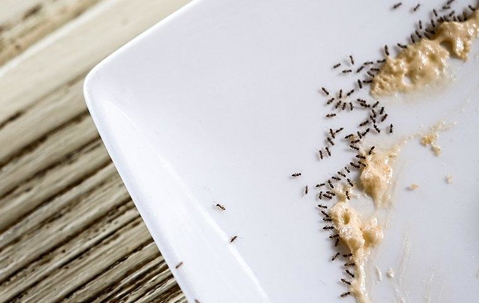Of the 12,000 species of ant in the world, some damage property, some cause health concerns, and others are labeled as nuisances. Like all nuisance species, odorous house ants carry a risk for food contamination, but their particular brand of nuisance is two-fold because of the odor they produce.
Odorous house ants have a pretty generic appearance. They are brown to black in color and relatively small, measuring between 1/16 and ⅛ inches in length. The thing that sets these ants apart is the strong rotten coconut-like smell they give off when crushed. While this may not be a public health risk, if you’ve ever smelled the after-effect of odorous house ants, you know it’s reason enough to keep this particular type of ant out of your home.
Preventing Odorous House Ants
Bad odors can be one of the toughest things to overcome following a pest infestation. Particularly with smelly pests like odorous house ants, prevention is far more desirable than waiting until elimination is necessary.
Keep odorous house ants from getting into your home by limiting the availability of the following:
- Food: Odorous house ants are attracted to food, especially food that is high in protein and grease, such as meats and cheeses. To limit this attraction, store food (including pet food) in airtight containers, wash dishes regularly, clean up spills and leftover food right away, and keep all trash cans covered with tight-fitting lids.
- Water: Odorous house ants are especially attracted to moisture-rich areas. Limit this draw by eliminating sources of standing water on your property, fixing leaks, ensuring drainage is working properly, and using dehumidifiers as needed.
- Access points: These ants are tiny. To limit their access to your home, you will need to seal all cracks in the foundation and exterior walls, use caulking to fill gaps around windows and doors, install door sweeps on exterior doors, and trim tree branches and other plants away from exterior walls.
- Landscaping: As with many pests, odorous house ants often begin their infestation in the yard before moving indoors. You can limit the odds of this happening on your property by taking steps to remove potential nesting areas. Odorous house ants are most likely to nest under rocks, logs, or other debris. Removing these factors from your lawn can reduce the chances of odorous house ants moving onto your property.
Taking measures to make your home less desirable to ants like odorous house ants is a smart move, but these measures will not stand up to an infestation that has already made itself at home on your property.
Eliminating Odorous House Ants
Any species of ant is hard to get rid of once it has established itself on your property. DIY methods of ant removal are often costly and simply not effective enough to eliminate the entire infestation. Rather than spending time and money on over-the-counter solutions that are unlikely to solve your problems, contact Quik-Kill Pest Eliminators at the first sign of an ant problem.
At Quik-Kill Pest Eliminators, we can identify the exact source of your pest problem and the scope of infestation. Our treatment options eradicate pests and ensure they don’t return. Don’t take chances with odorous house ants or other nuisance pests. Keep your food fresh and your home smelling its best by trusting our trained professionals.

